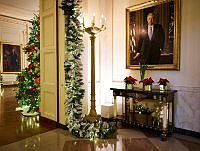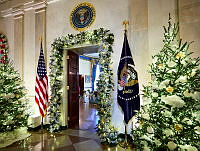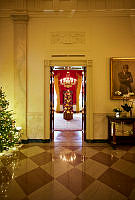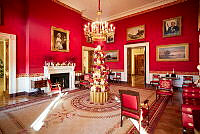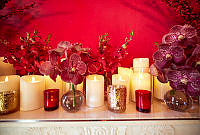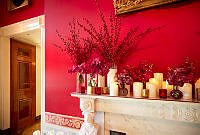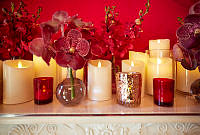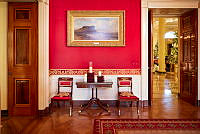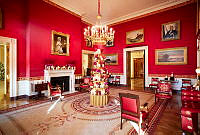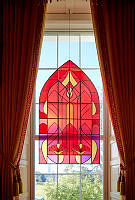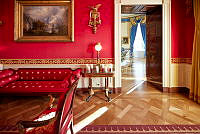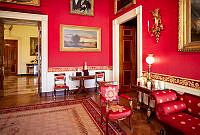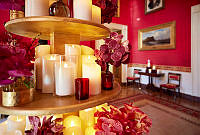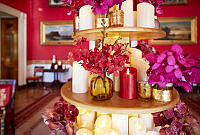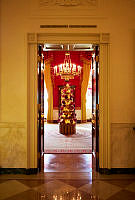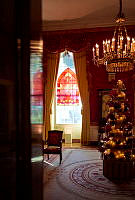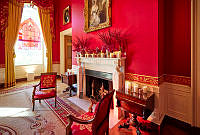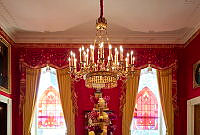President Thomas Jefferson's White House Museum
Painting by Peter Waddell
Copyright © Fall 2013 White House Historical Association. All rights reserved under international copyright conventions. No part of this article may be reproduced or utilized in any form or by any means, electronic or mechanical, including photocopying, recording, or by any information storage and retrieval system, without permission in writing from the publisher. Requests for reprint permissions should be addressed to books@whha.org
An issue about the White House and the West naturally draws one’s attention to the expansionism experienced during Jefferson’s administration. While the glow of new, cheap land way out there somewhere reverberated in the average citizen’s mind, natural curiosity made him or her wonder also what the West was like. People knew it was different, and might have suspected that it would be the spine of Americans’ interests and ambitions for ninety or so years to come.
Thomas Jefferson made the Entrance Hall of the White House a museum to tell about this mysterious west that so fascinated the public. Perhaps Americans’ fascination with cowboys and Indians began here. Artifacts brought back by Meriwether Lewis and William Clark and by Zebulon Pike were hung up in the great space, announcing dramatically the achievements of exploration and the promise of the West. Perhaps Jefferson had seen “curiosity cabinets” when he toured stately residences in Europe; surely he had seen in England the flamboyant displays of firearms in similar halls in similar houses.
Jefferson opened the house to the public in the spring of 1801, another idea almost certainly inspired by palaces and stately homes he had seen. Over the years to the end of his two terms he created an amazing exhibit for the public to see. To satisfy our desire to illustrate Jefferson’s Entrance Hall museum, we commissioned the historical artist Peter Waddell to paint an image that represented it as it was about 1807. His research took him to Monticello, the National Archives, and other depositories and of course because of his previous work he is expert on the physical White House as it has been through time.
Here Waddell shows the trophies brought back by the explorers, the arrows, headdresses of the Indians, animal skins, and samples of crops. Jefferson’s collection had become very large, including two grizzly bear cubs, who were kept in a large pen outside the door and performed gaily for callers who flocked to visit the President’s House.
The picture tempts one to recall other activities in this room. Imagine it in use for a grand dinner with its exotic contents peering shadowy in the glow of a few candles, the high plaster walls making echoes, the rich Pennsylvania blue marble columns looming over all. This hall was Jefferson’s state dining room in the unfinished house. A practical president covered the floor in painted and varnished canvas, to catch crumbs.

Written documents in the National Archives and in Thomas Jefferson’s papers describe the Entrance Hall museum but no graphics survive to suggest the actual arrangement. Peter Waddell has brought the documents to life in an imagined portrait of the interior as Jefferson may have arranged it. Watercolor on Archer paper by Peter Waddell, 2012.

Written documents in the National Archives and in Thomas Jefferson’s papers describe the Entrance Hall museum but no graphics survive to suggest the actual arrangement. Peter Waddell has brought the documents to life in an imagined portrait of the interior as Jefferson may have arranged it. Watercolor on Archer paper by Peter Waddell, 2012.

Written documents in the National Archives and in Thomas Jefferson’s papers describe the Entrance Hall museum but no graphics survive to suggest the actual arrangement. Peter Waddell has brought the documents to life in an imagined portrait of the interior as Jefferson may have arranged it. Watercolor on Archer paper by Peter Waddell, 2012.














